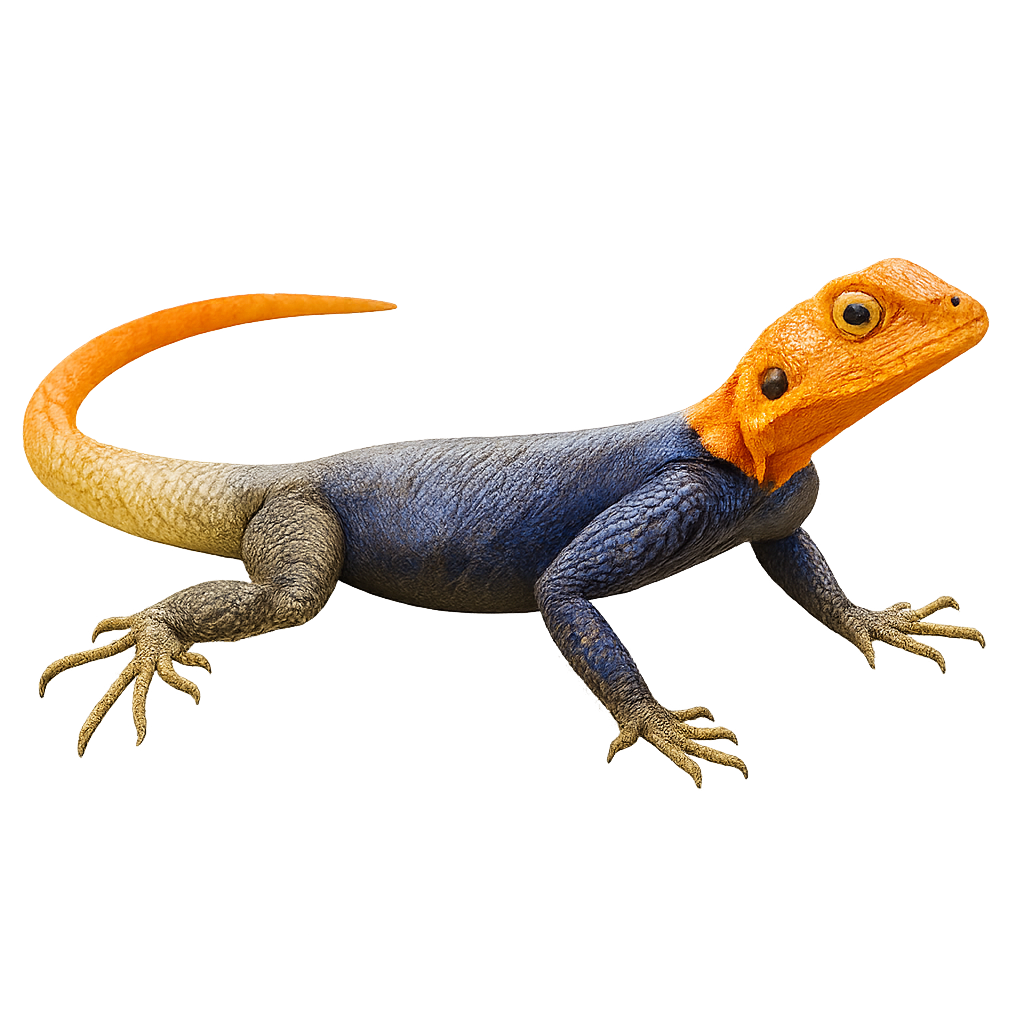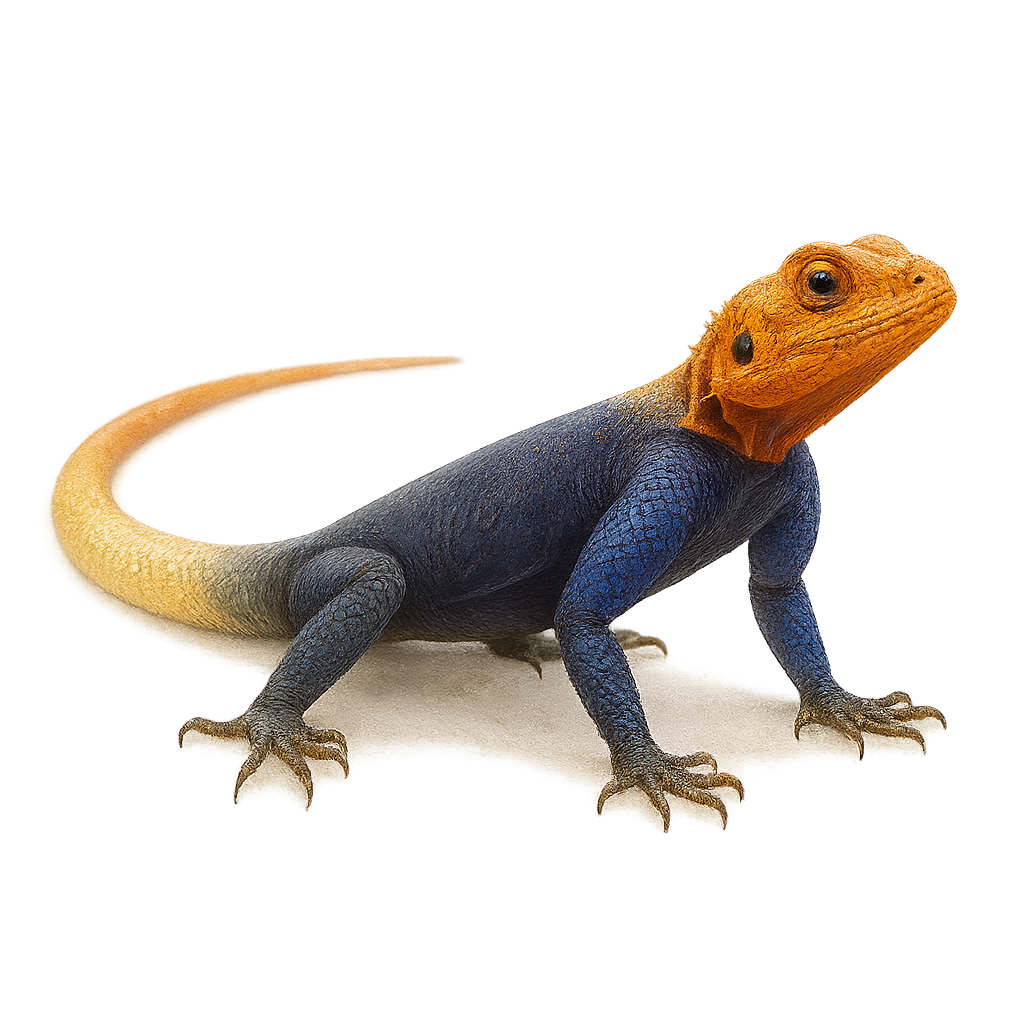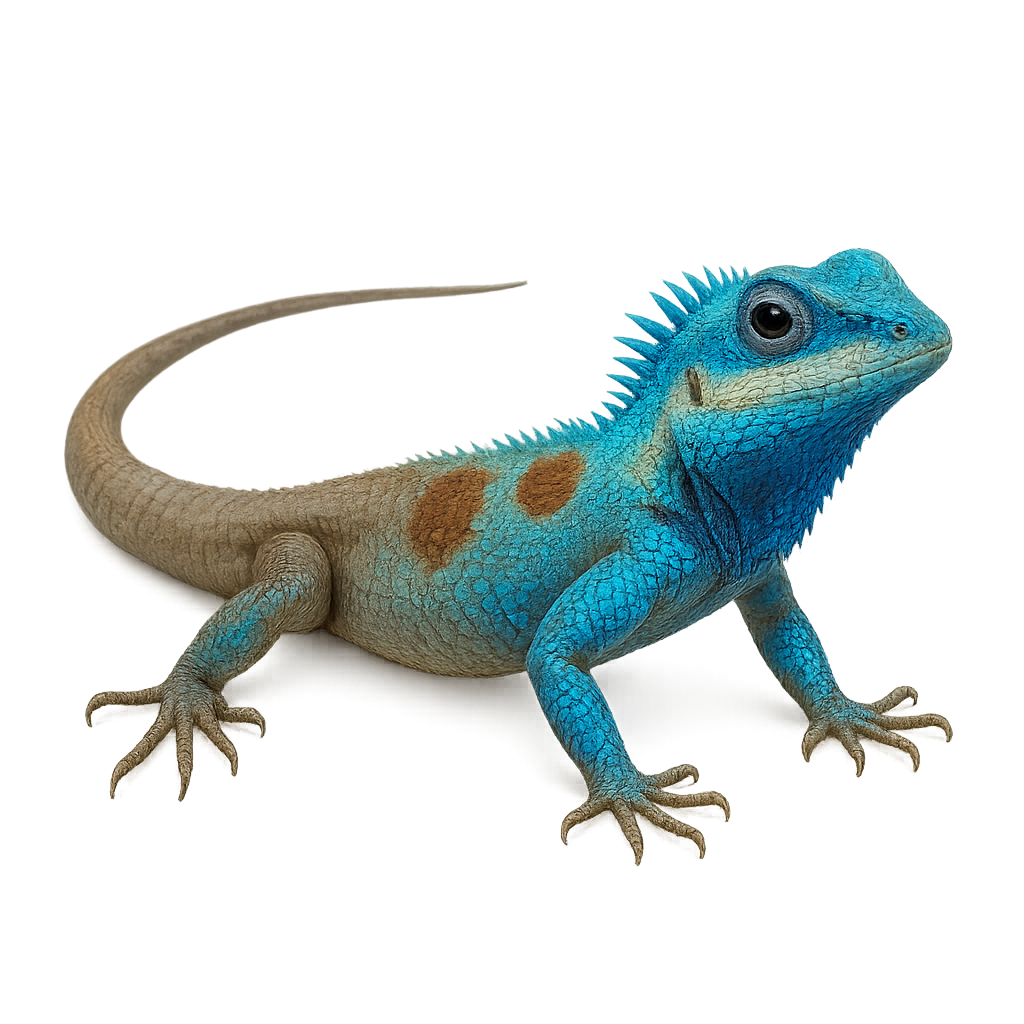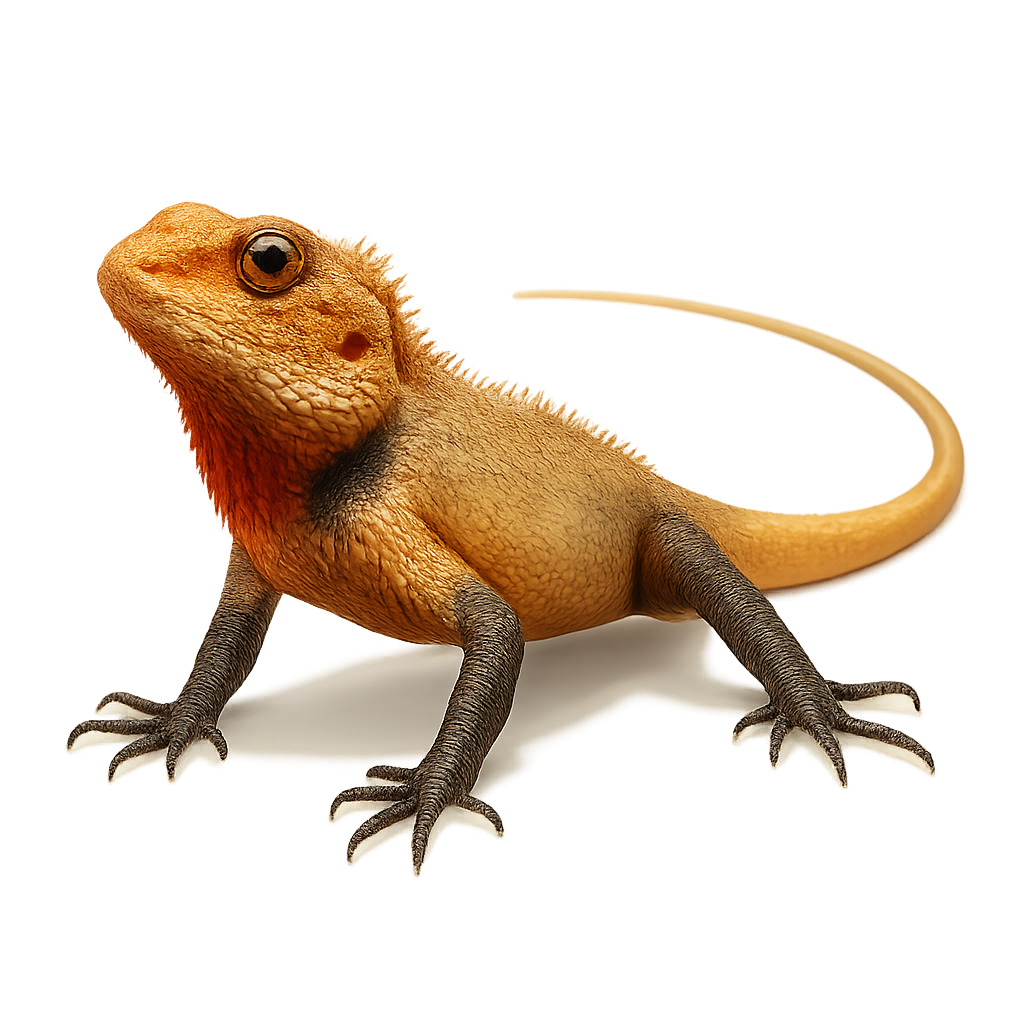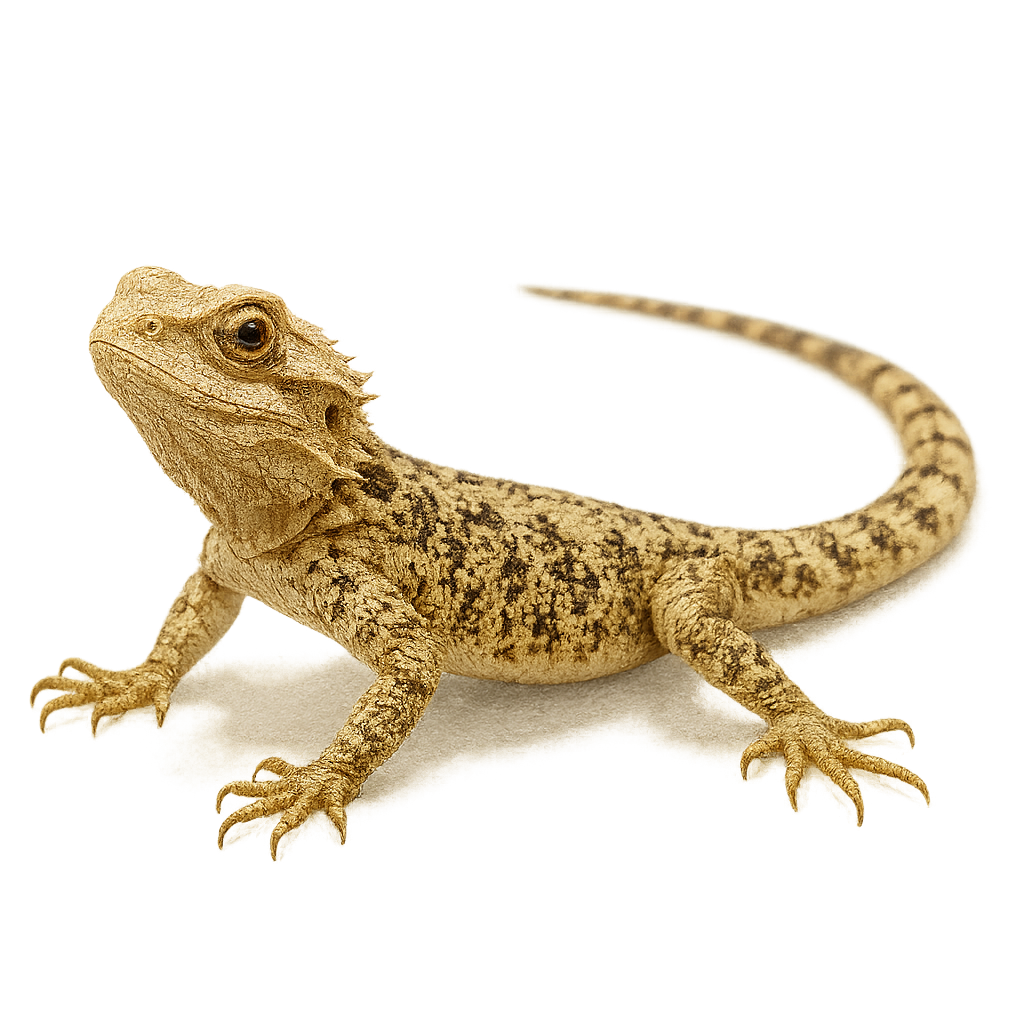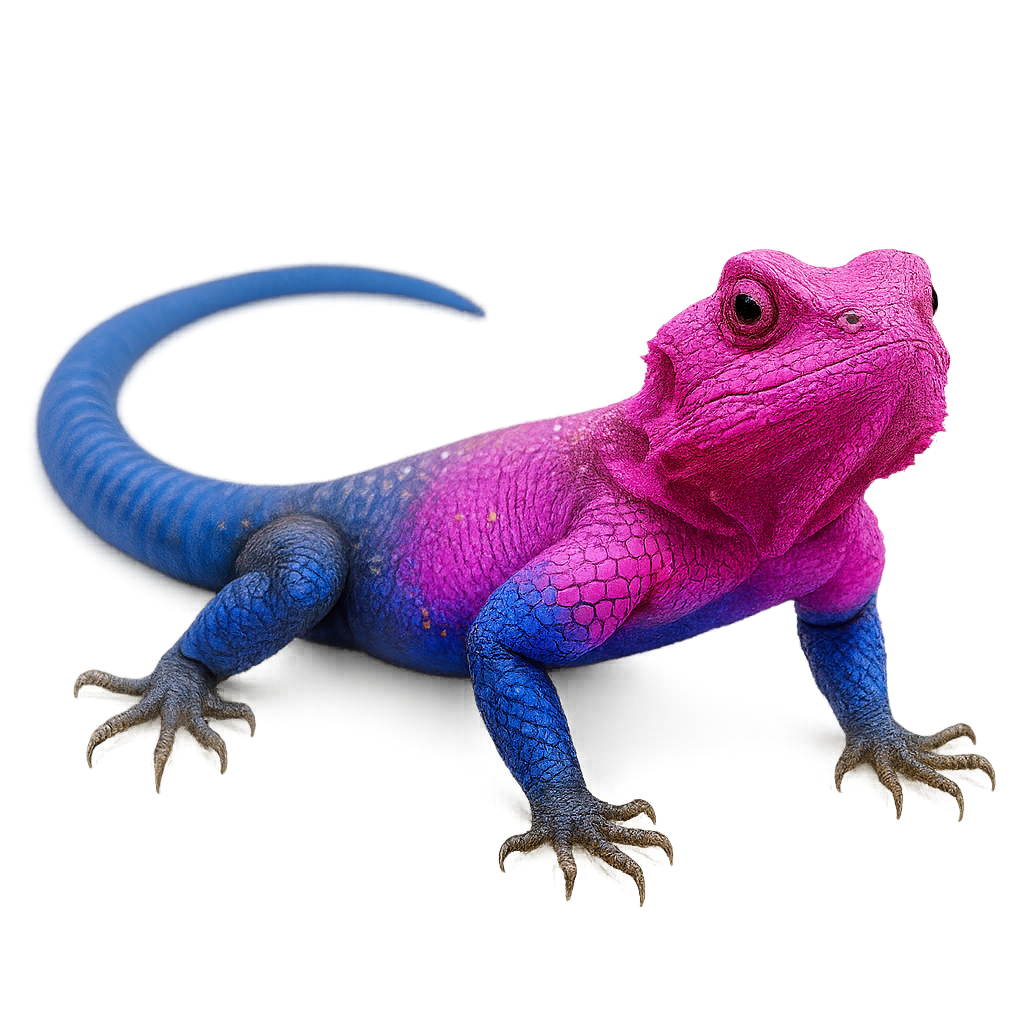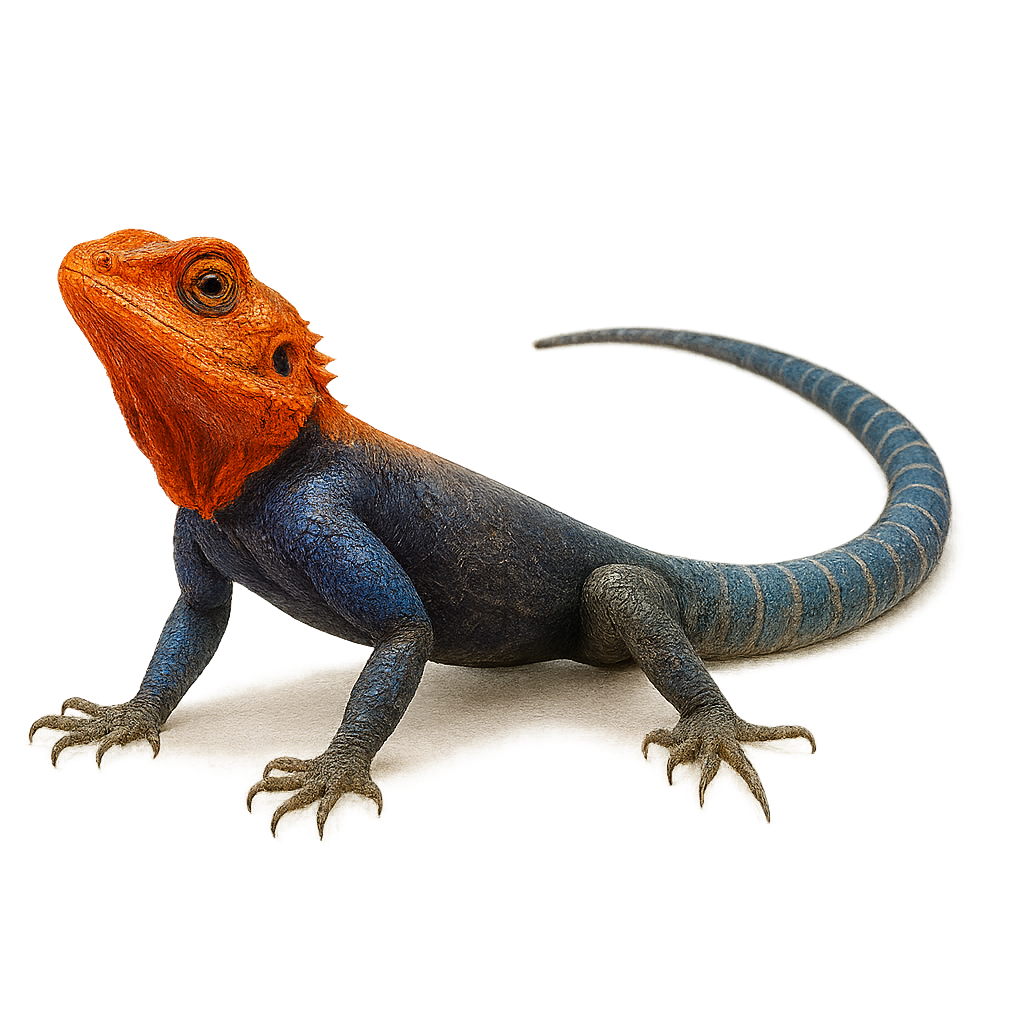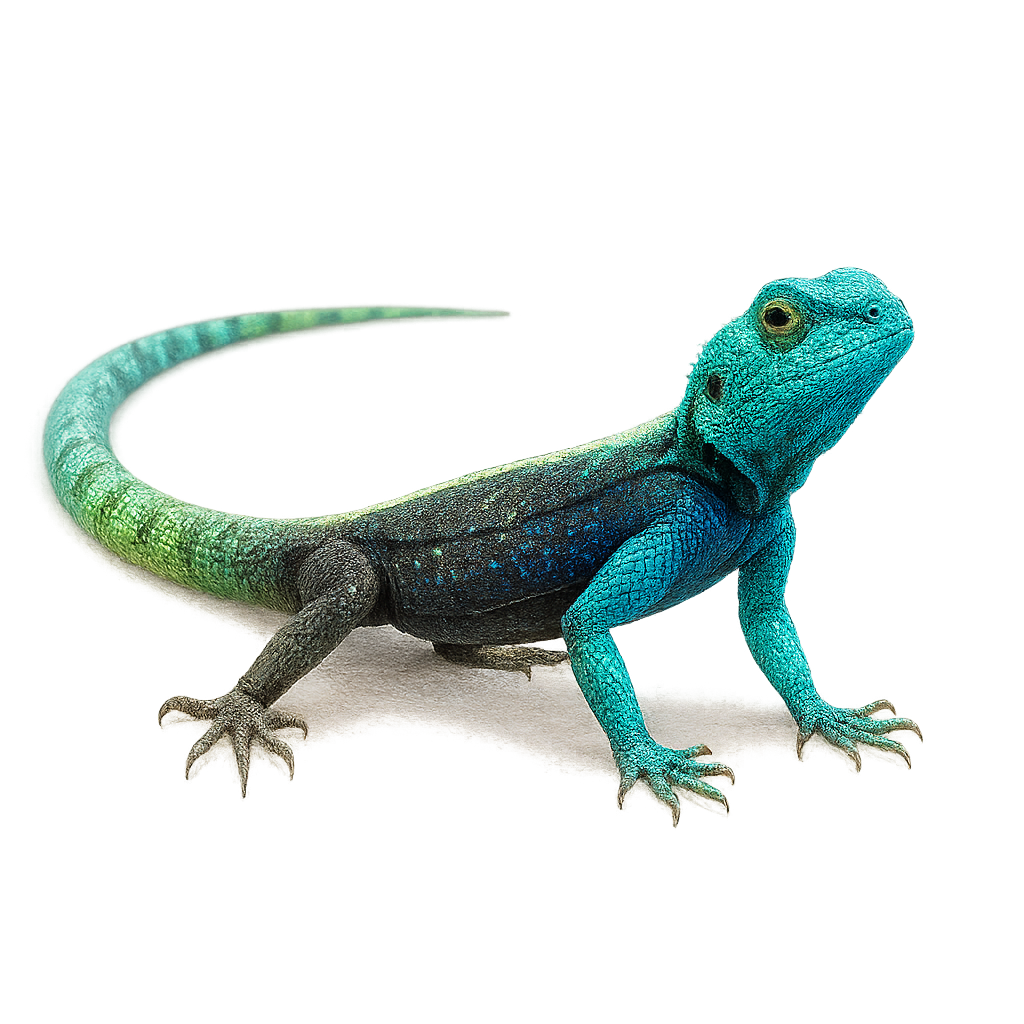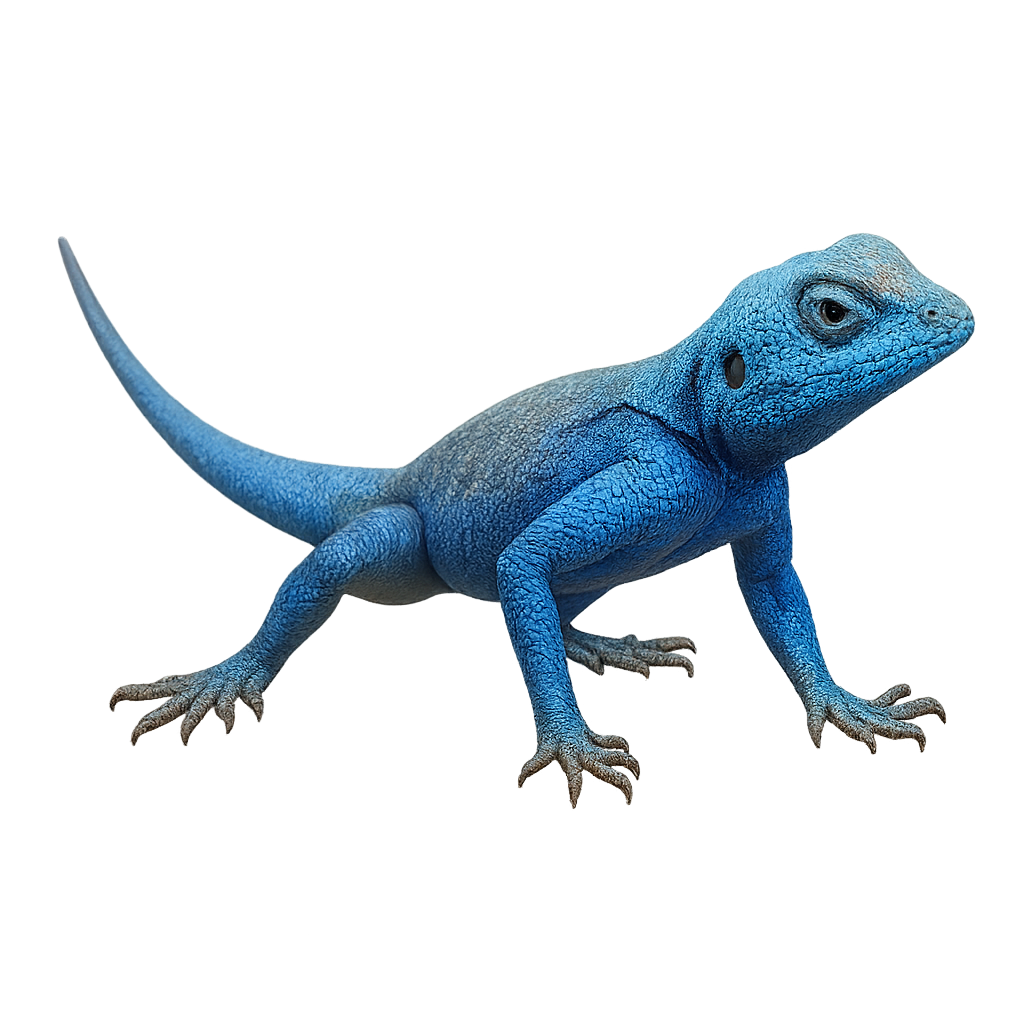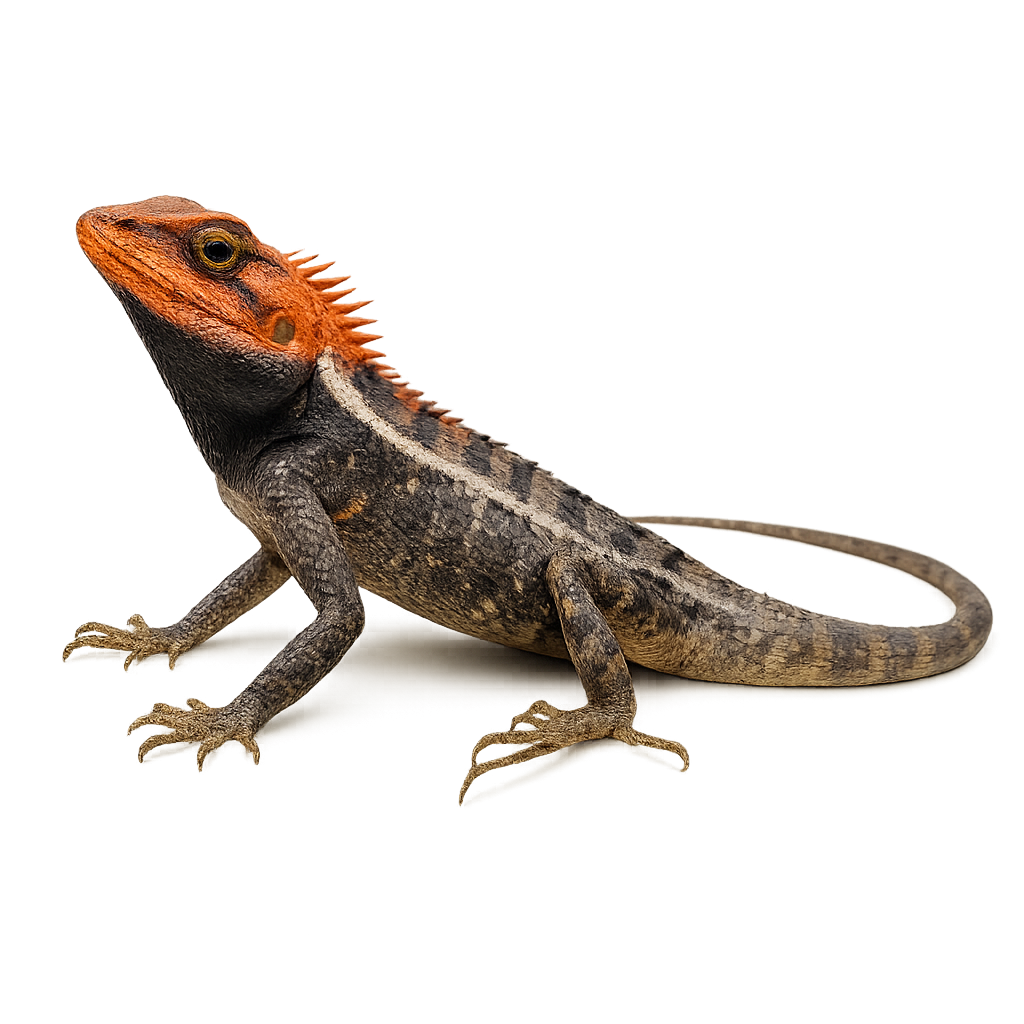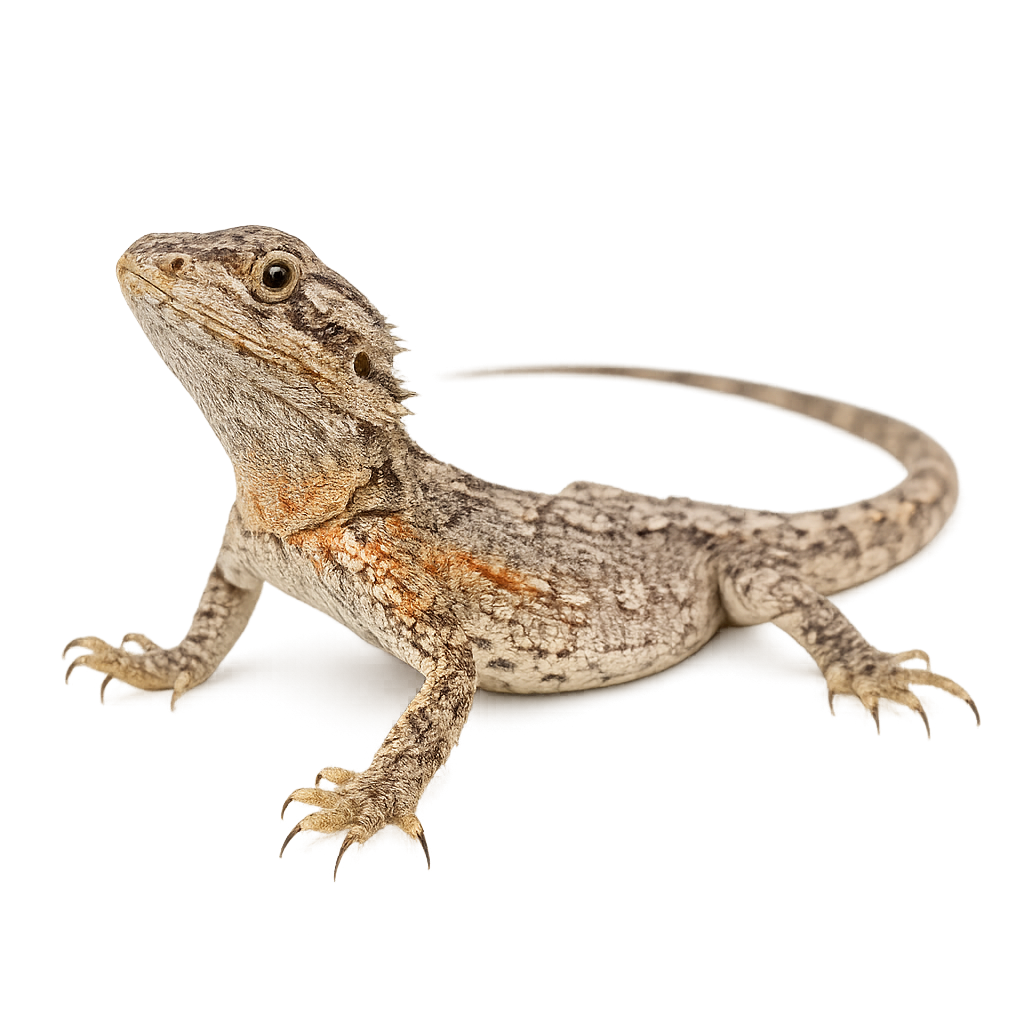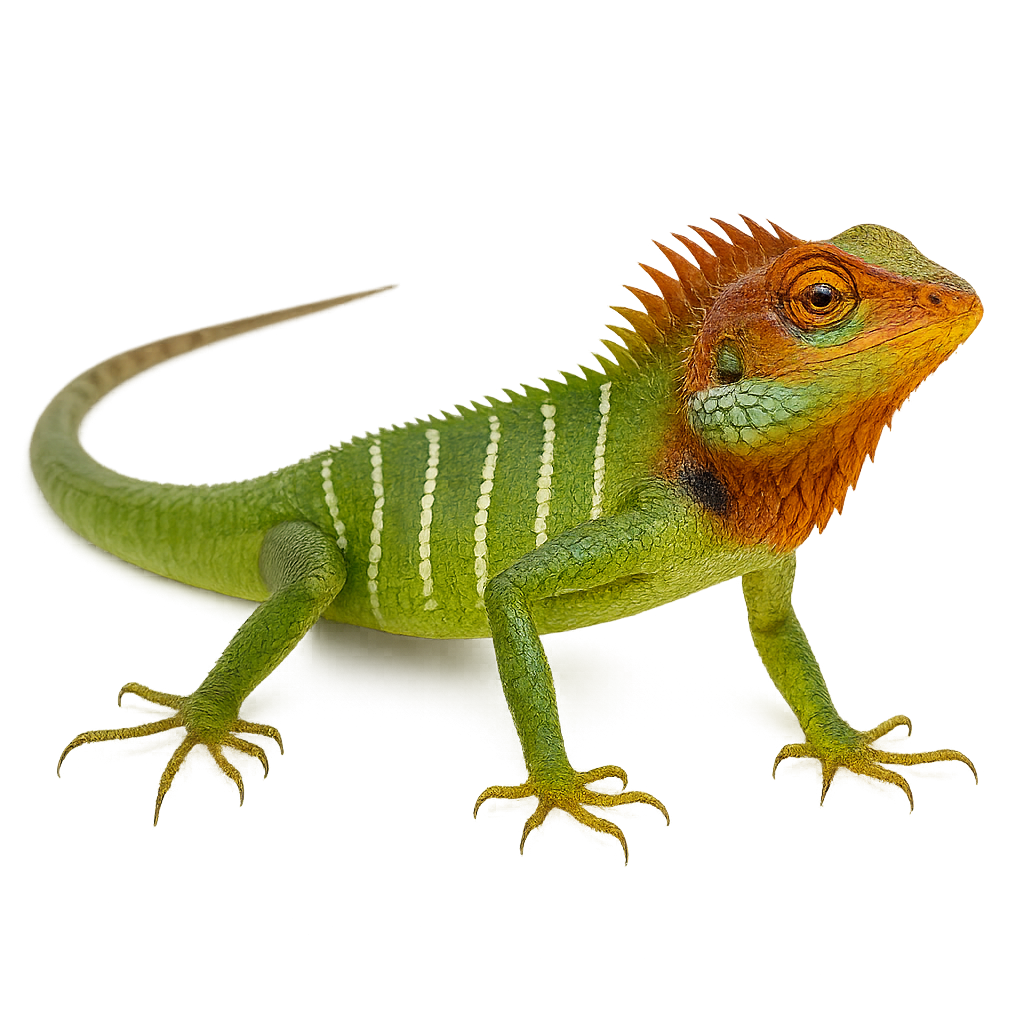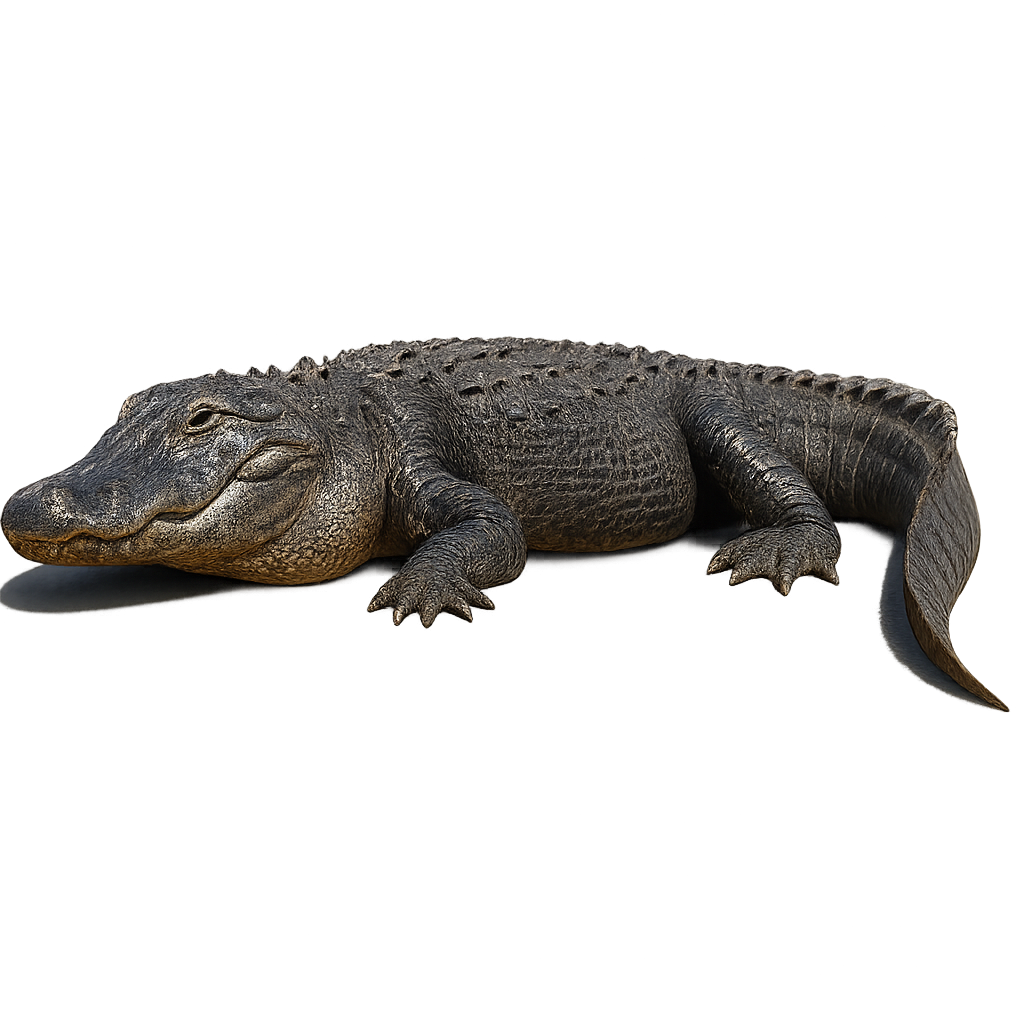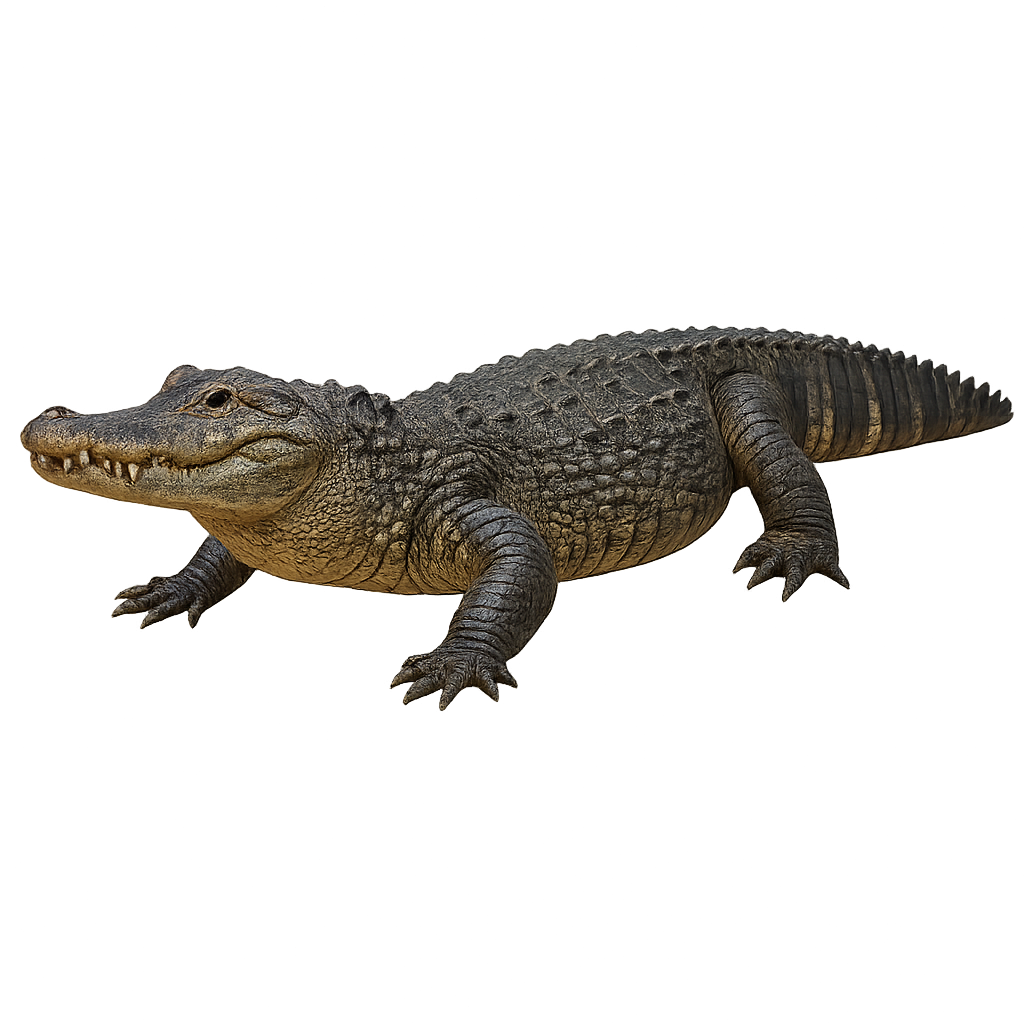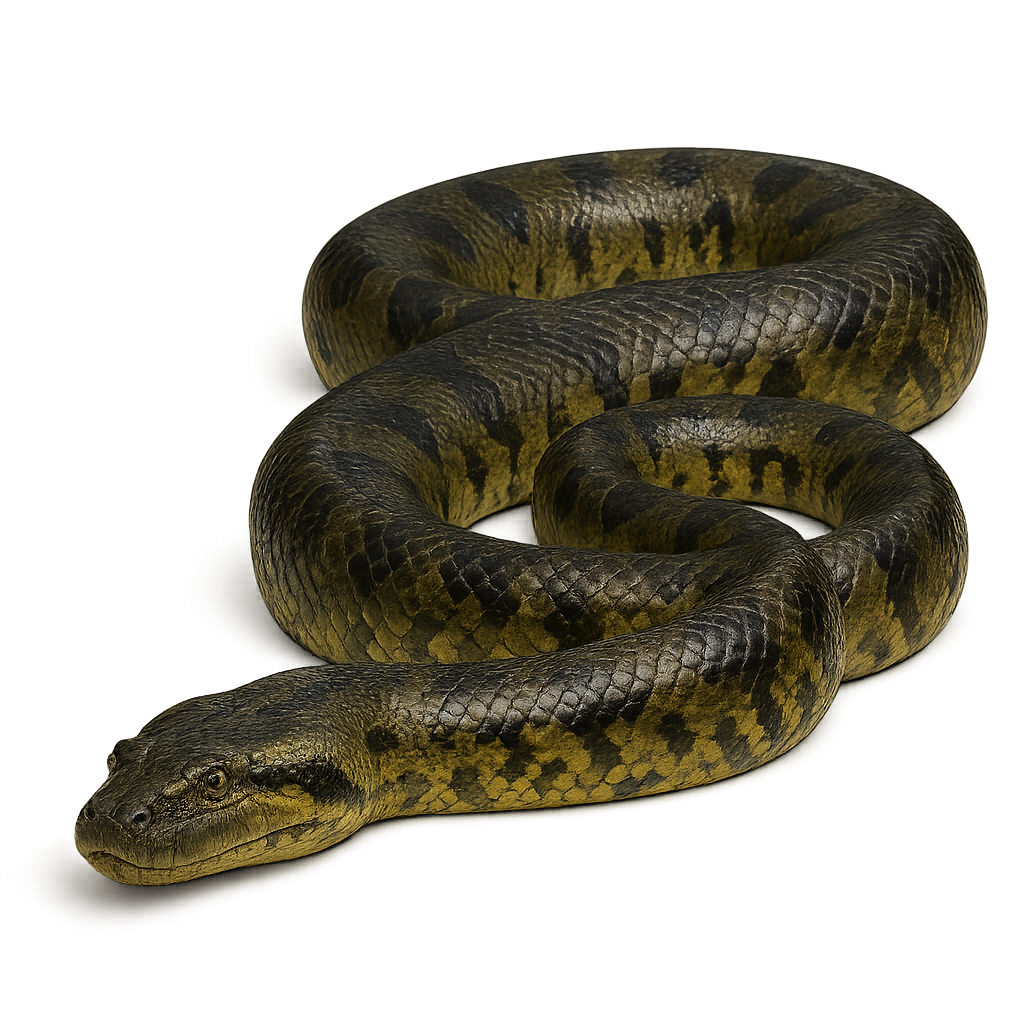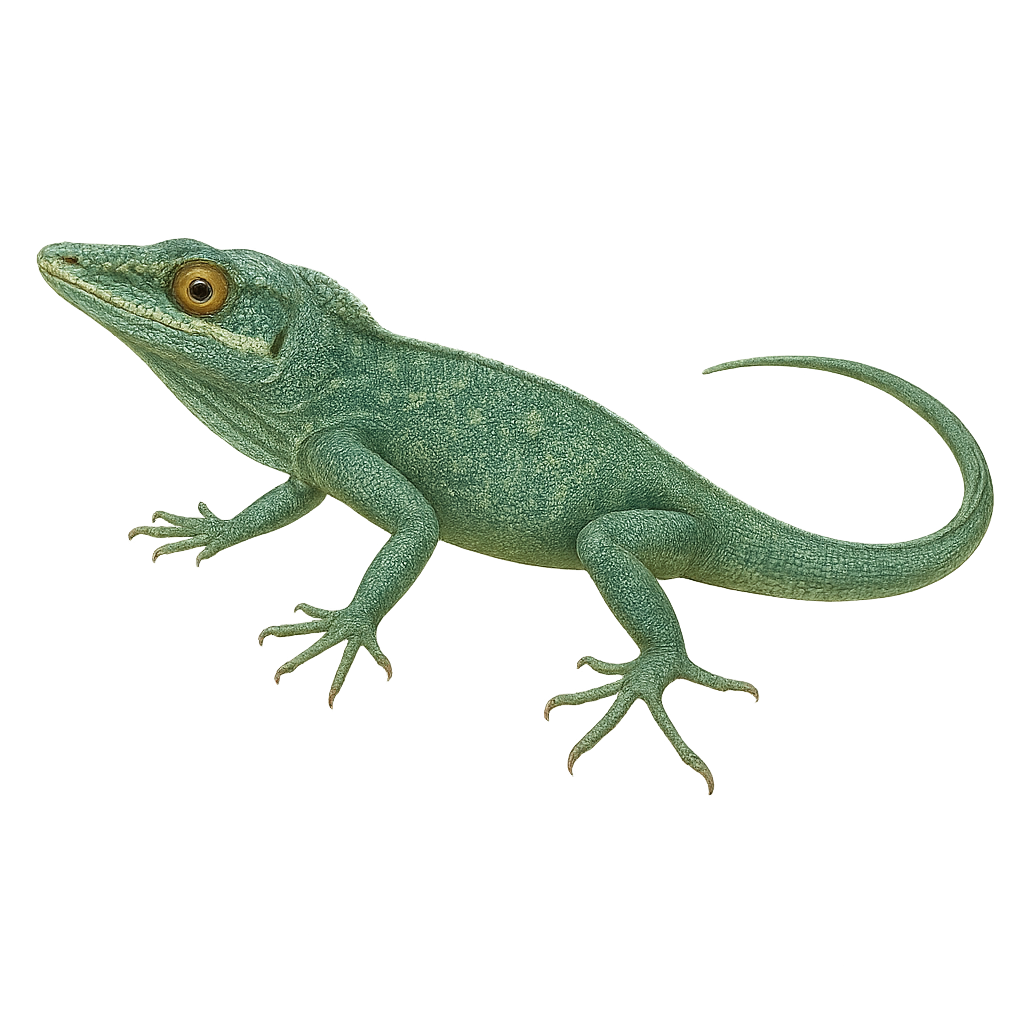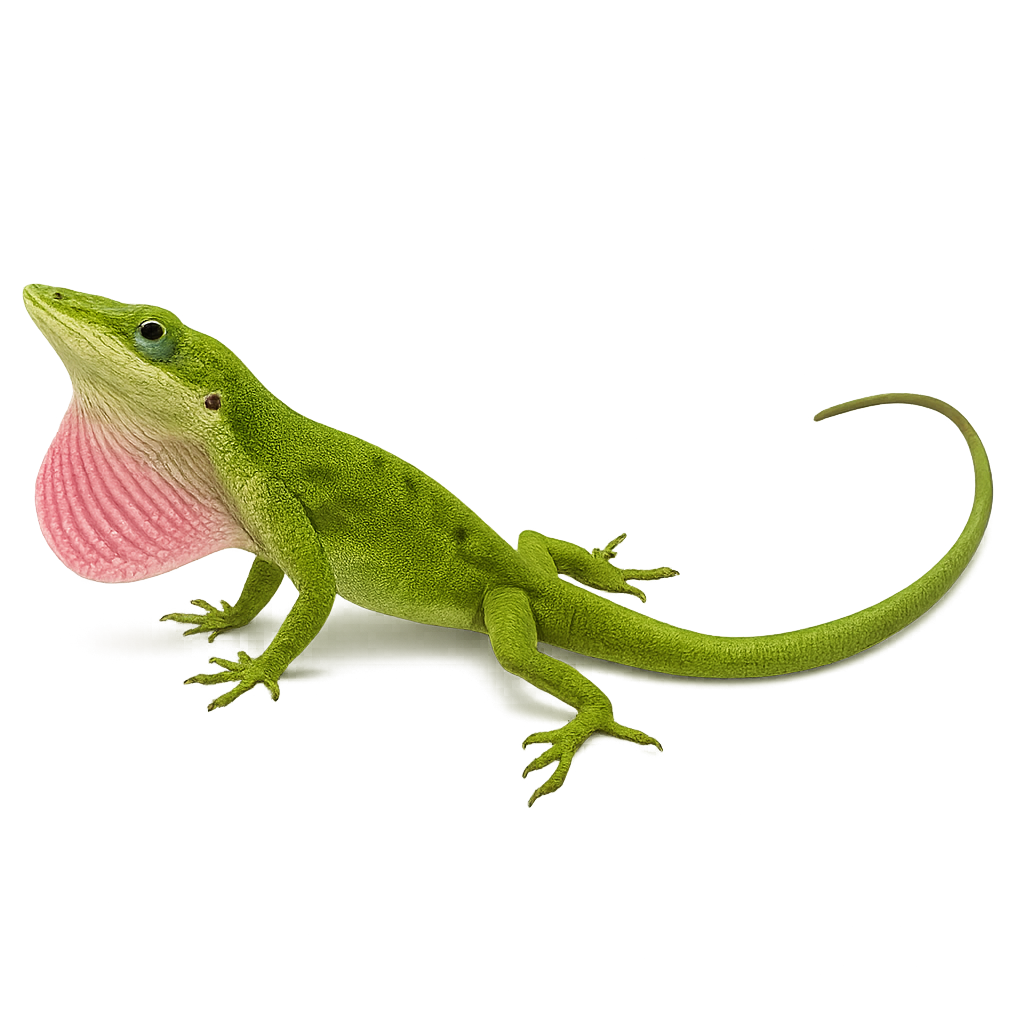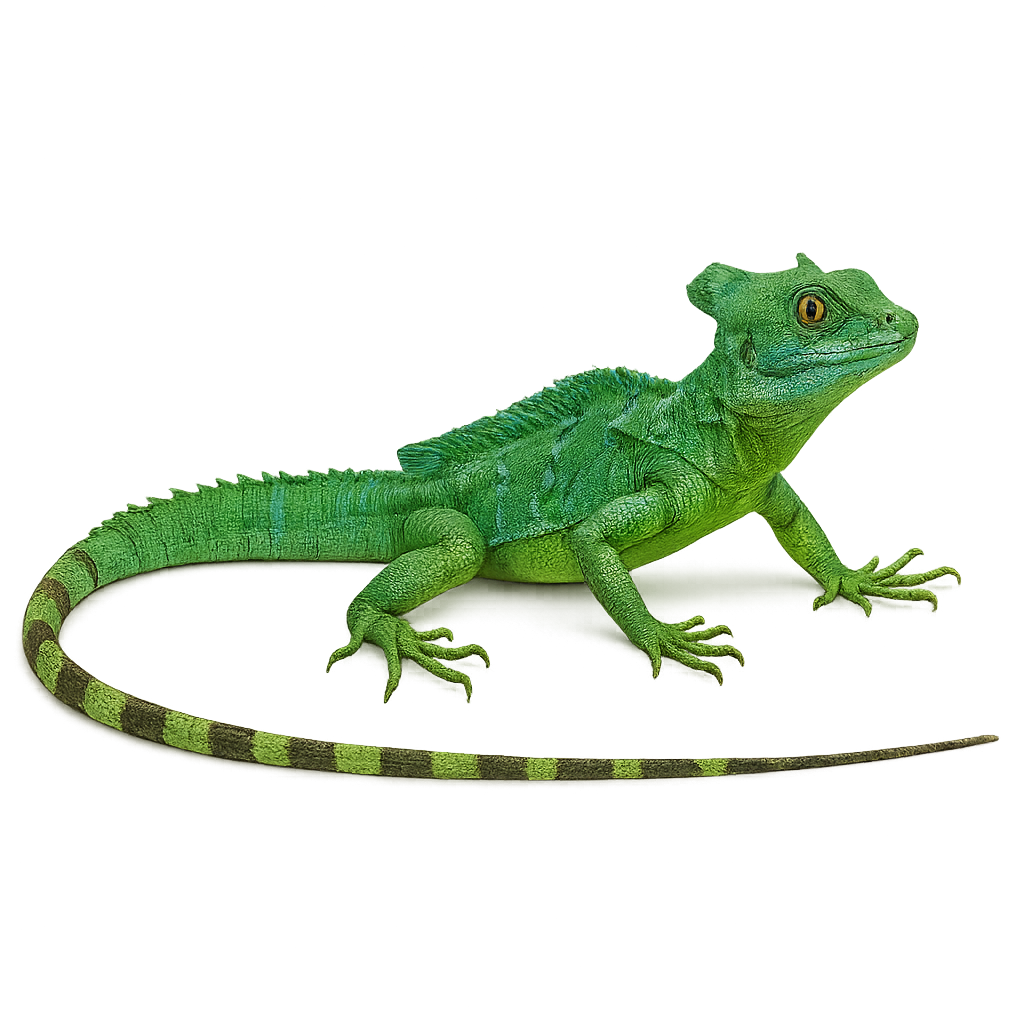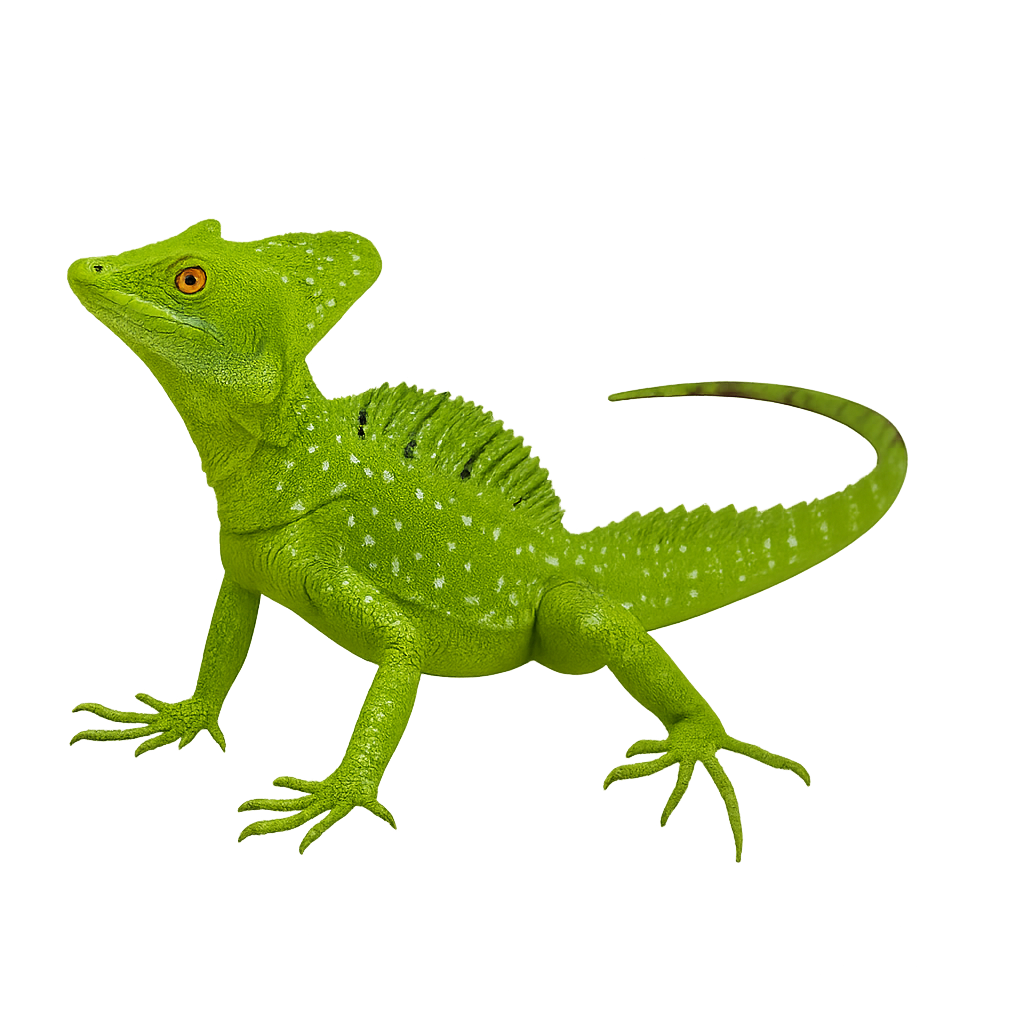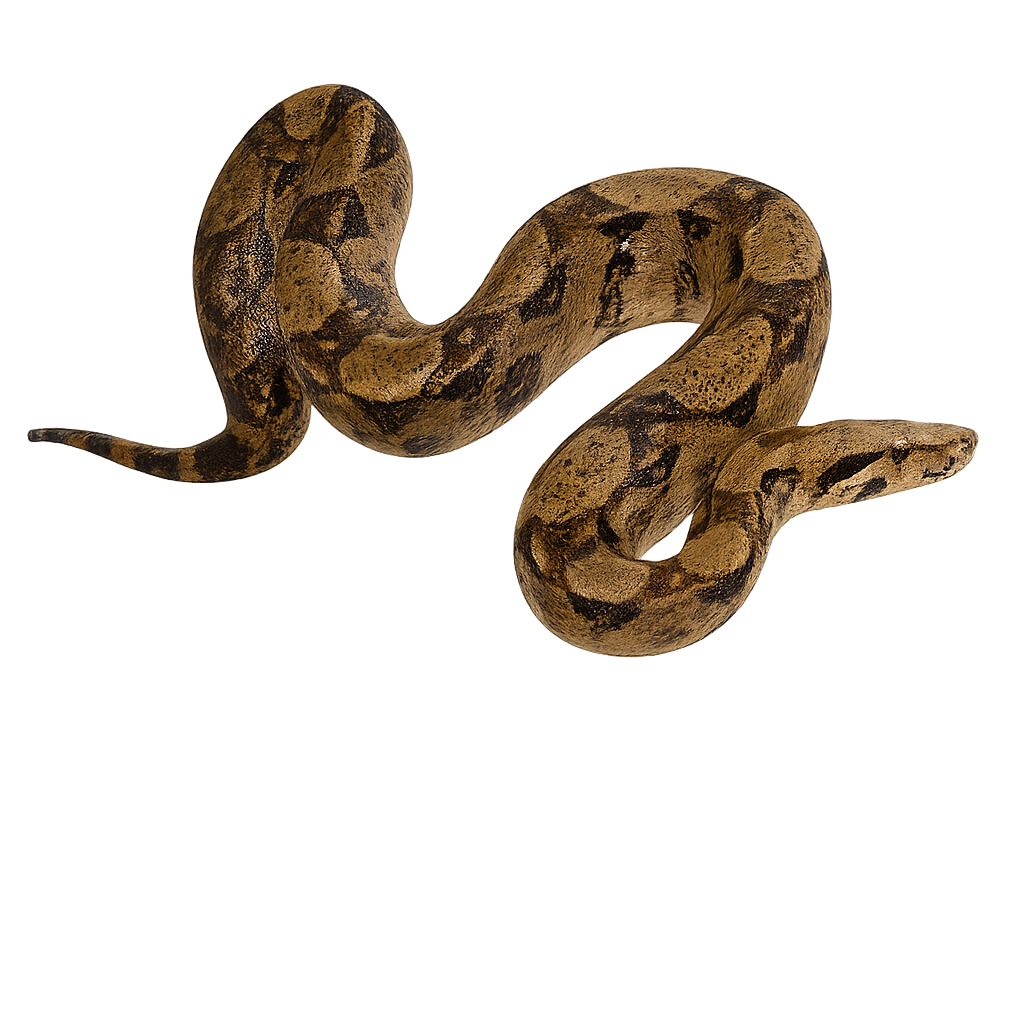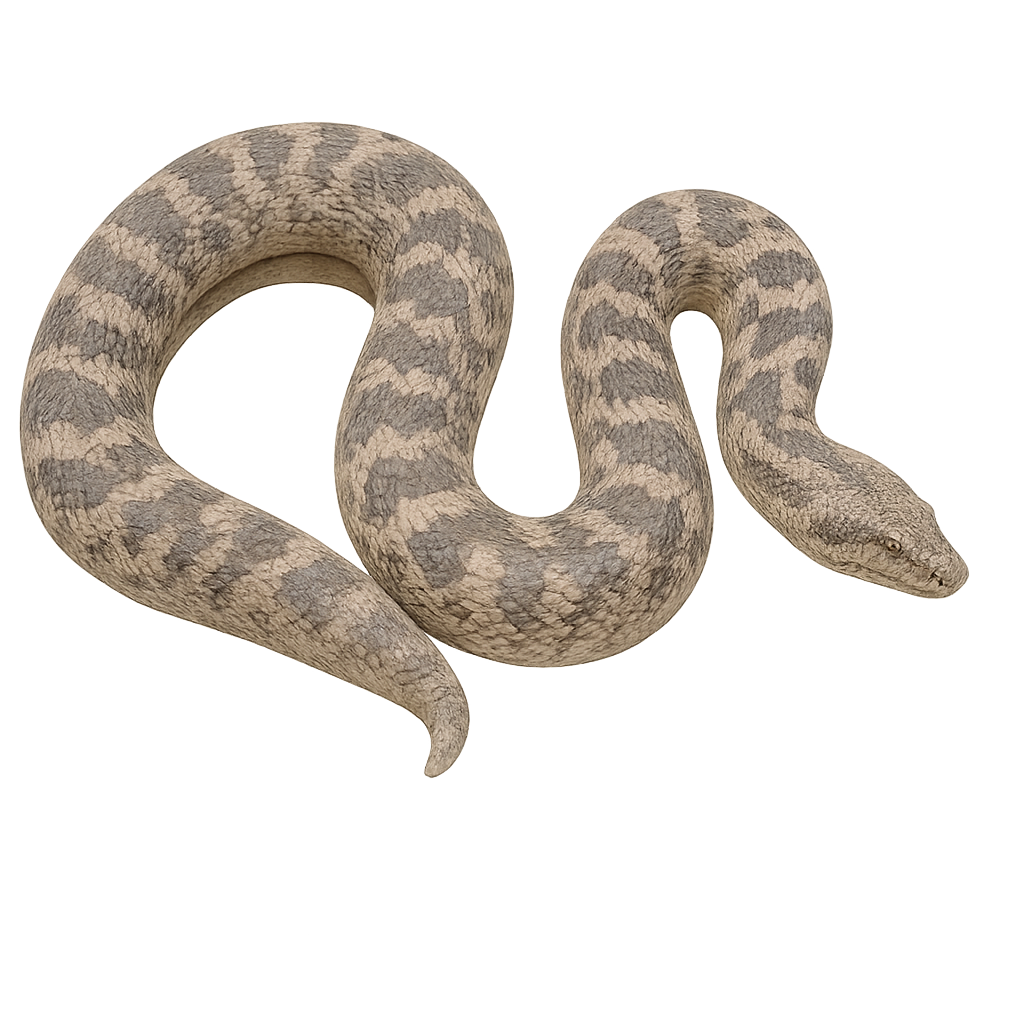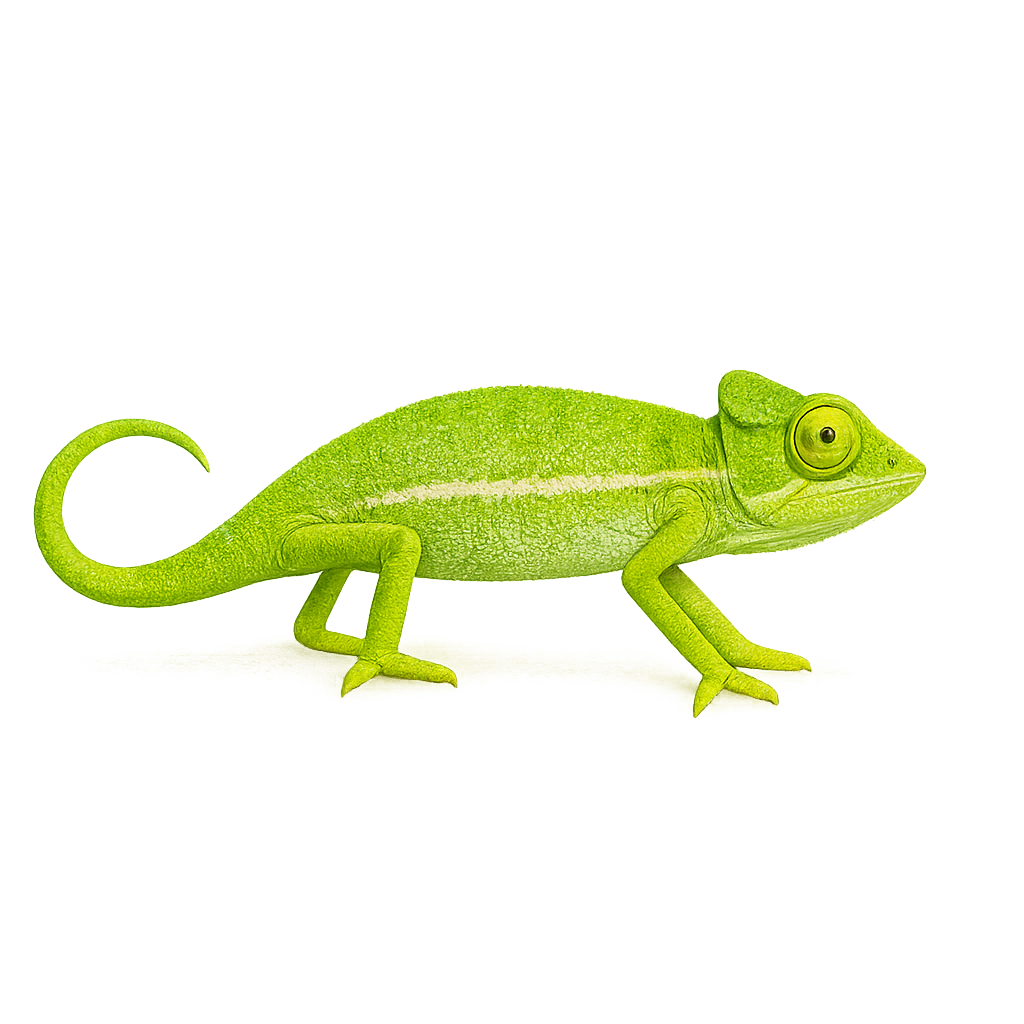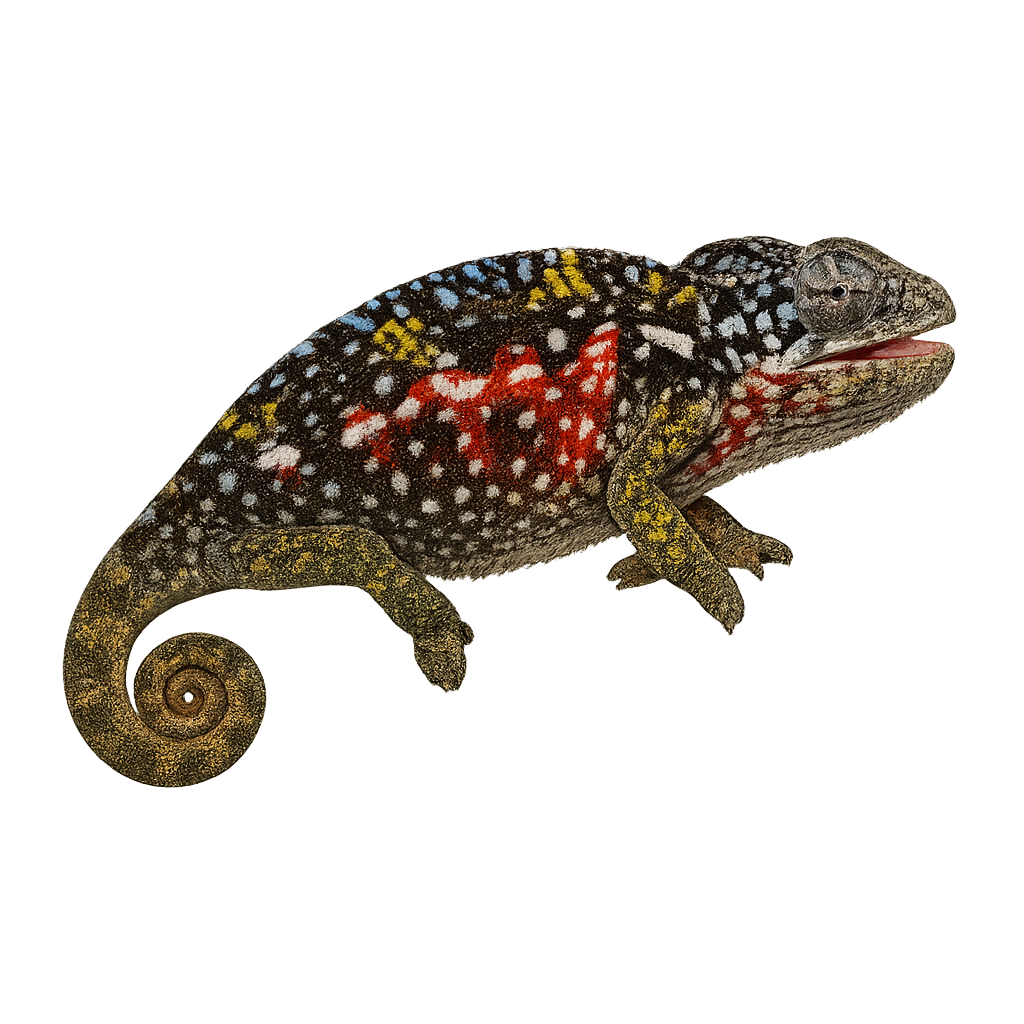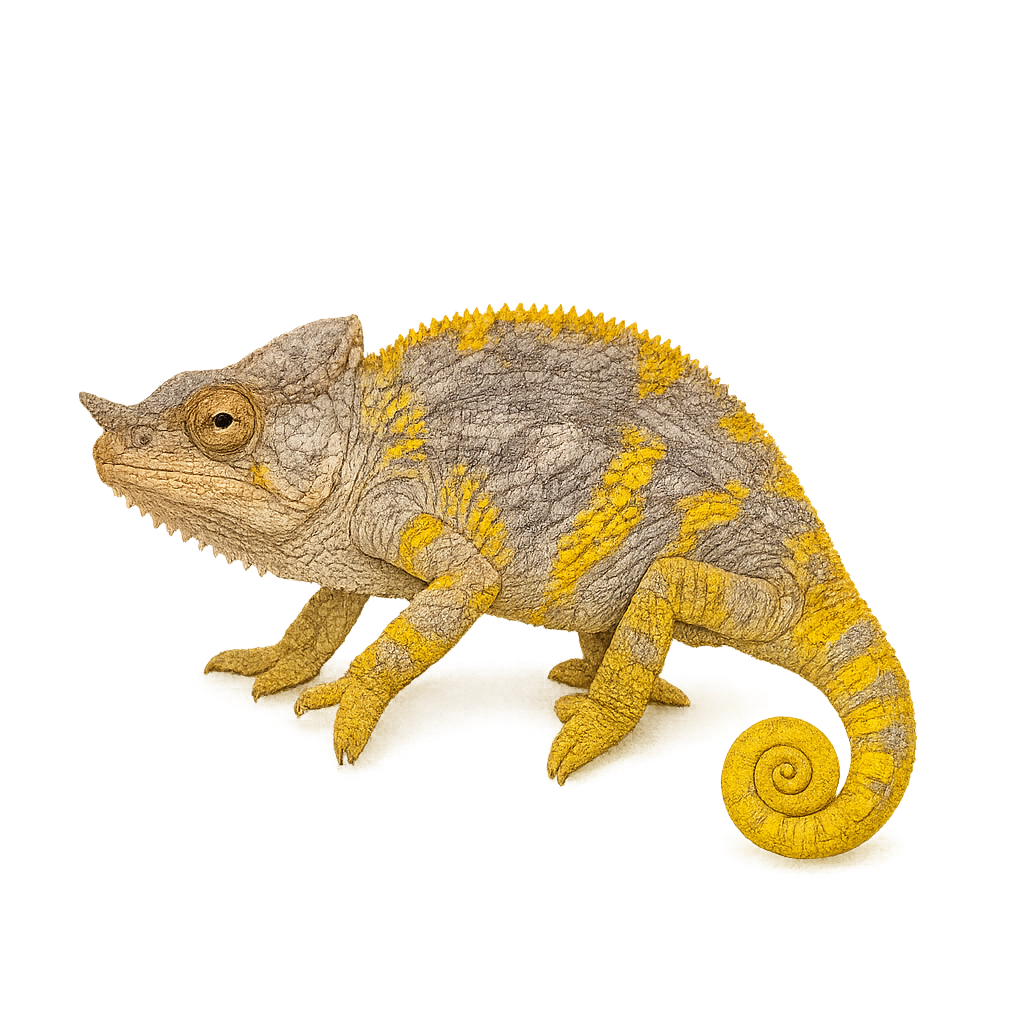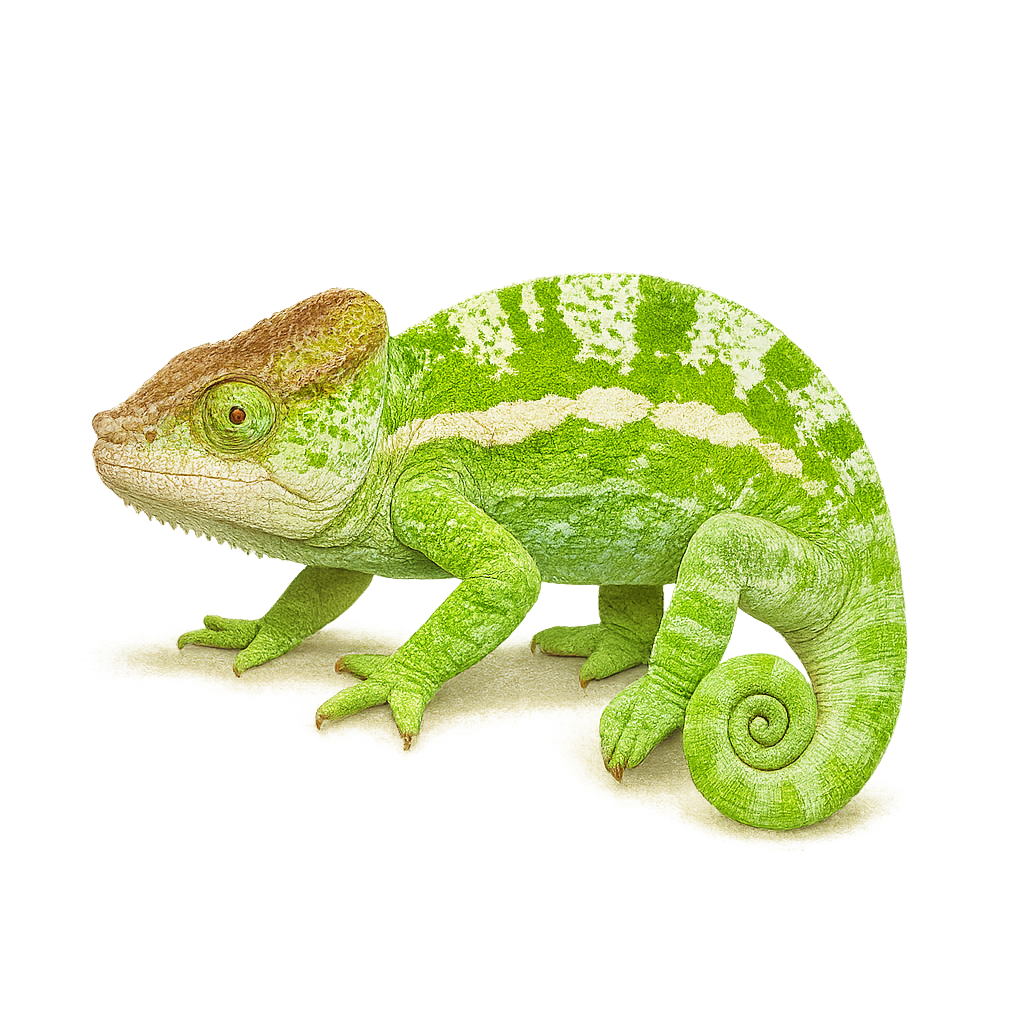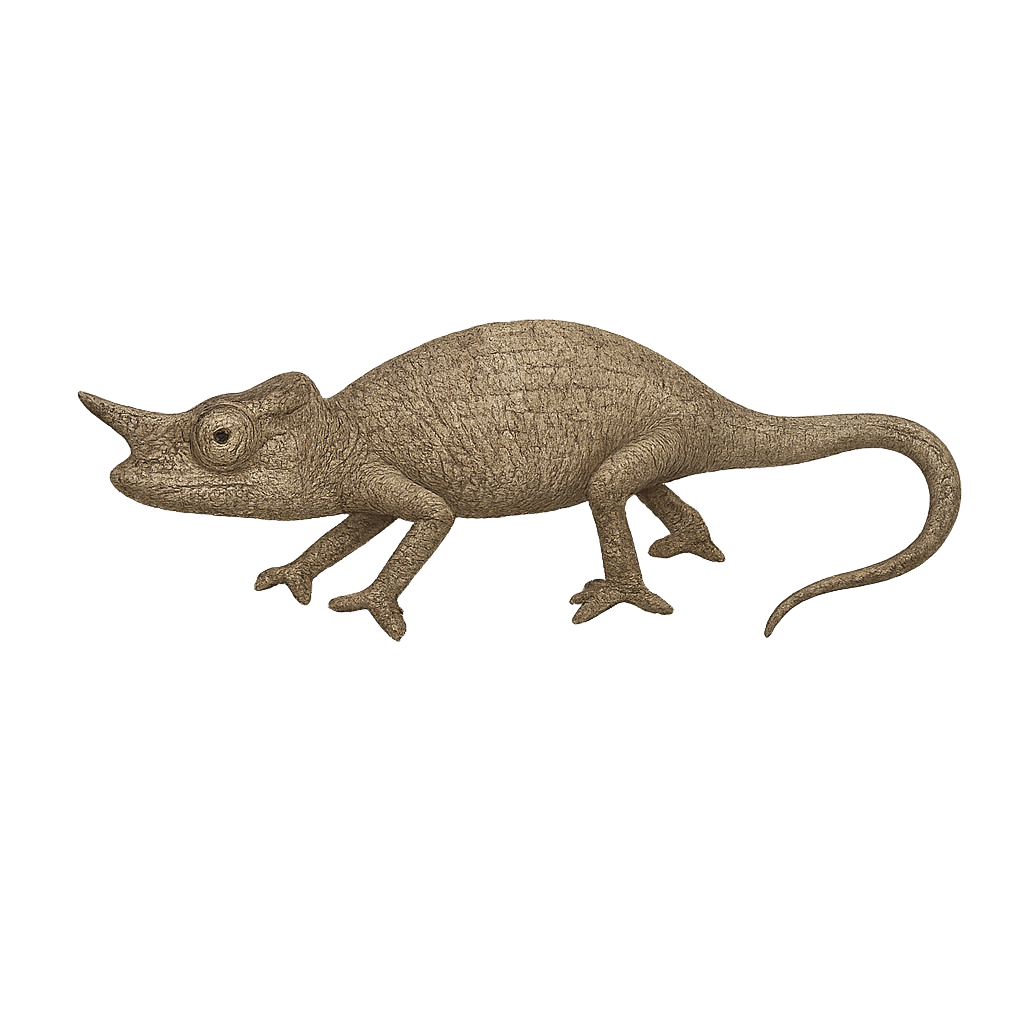The Painted Agama, Agama picticauda, is a colorful lizard native to West Africa. It is known for its vividly patterned tail and bright colors, ranging from brown to red, with hints of blue and green. This lizard is often found in rocky areas and savannas, basking in the sun. It is diurnal and primarily feeds on insects. Males are generally more colorful than females, especially during the breeding season. Although relatively tolerant of human presence, it prefers to keep its distance. Its ability to change color depending on its mood or environment is fascinating and makes it popular among reptile enthusiasts.
The Namibian Rock Agama, or Agama planiceps, is a fascinating lizard found primarily in the arid regions of southern Africa, particularly in Namibia and Botswana. This reptile is easily recognizable by its flattened head and vibrant coloration, especially in males who display bright blue and orange hues during the breeding season. Females and juveniles, on the other hand, exhibit duller colors, usually in shades of brown and gray. The Namibian Rock Agama is a diurnal animal that spends most of its time basking in the sun on rocks or hunting insects. It is well adapted to its dry environment and can survive with very little water, obtaining necessary moisture from its food.
The Calotes mystaceus, or Indochinese Forest Lizard, is an arboreal lizard native to Southeast Asia, particularly found in Thailand, Myanmar, and Laos. It is recognizable by its vibrant coloration, often green with shades of blue and red, and its prominent scales around the head resembling a mustache. This lizard typically measures between 25 and 35 cm in length, including the tail. It prefers tropical rainforests and wooded areas, where it primarily feeds on insects and small invertebrates. Active during the day, it is often seen basking in the sun on branches or tree trunks. Although relatively common in its natural habitat, it can be difficult to spot due to its effective camouflage.
The Uromastyx aegyptia, or Egyptian spiny-tailed lizard, is a robust lizard of 30–40 cm snout-vent length, with a long spiny tail used for defense. It inhabits rocky deserts and semi-arid steppes of North Africa and the Middle East. An opportunistic herbivore, it feeds on leaves, flowers, and succulent fruits. During the breeding season (April 1 to May 31), males become more colorful and perform threat displays, whipping their spiny tails in rivalry.
The Changeable Lizard, or Calotes versicolor, is a widespread lizard in South and Southeast Asia. It is easily recognizable by its ability to change color, shifting from brown to green, and sometimes bright red, especially during the breeding season. This diurnal lizard prefers open habitats such as gardens, light forests, and urban areas. It primarily feeds on insects but can also consume small vertebrates. Males often display a reddish throat during the breeding season to attract females. Although frequently seen in inhabited areas, it remains wary and quickly flees when threatened.
Lehmann's Agama is a fascinating lizard known for its adaptability to various environments. This reptile is primarily found in mountainous regions, where it skillfully camouflages itself among rocks and shrubs. Its coloration can vary, but it often exhibits shades of brown and gray that allow it to blend into its natural habitat. Lehmann's Agama is a diurnal animal, active mainly during sunny hours. It primarily feeds on insects and small invertebrates. Although its behavior is generally suspicious, it can become more tolerant of humans if not disturbed.
The Mwanza Flat-headed Agama, Agama mwanzae, is a colorful lizard native to East Africa, particularly in Tanzania, Kenya, and Rwanda. It is famous for its striking resemblance to Spider-Man, due to its bright red head and blue body. This diurnal lizard prefers rocky habitats where it can bask in the sun. Males are territorial and can be seen strutting to attract females. Although primarily insectivorous, it can also consume fruits and flowers. Its ability to change color for camouflage or communication is fascinating. The Mwanza Flat-headed Agama is a perfect example of adaptation and diversity in African wildlife.
The Common Agama, or Agama agama, is a colorful and fascinating lizard found primarily in sub-Saharan Africa. This reptile is known for its ability to change color, especially males who display bright hues of blue and orange during the breeding season. Typically measuring between 25 and 30 cm in length, it has a long, slender tail. The Common Agama is a diurnal animal that prefers warm, dry environments such as savannas, rocky areas, and villages. It primarily feeds on insects but can also consume small vertebrates and plants. This lizard is social and lives in hierarchical groups, where a dominant male controls several females and subordinates.
The Agama atra, or Southern Rock Agama, is a robust and colorful lizard native to the rocky regions of southern Africa. It is easily recognizable by the bright blue head of the males, contrasting with a brown or gray body. Females and juveniles are generally duller, displaying brown or gray hues. This diurnal lizard is often seen basking in the sun on rocks or walls, using its color to blend into its surroundings. It is territorial, with males vigorously defending their space against intruders. Its ability to change color to regulate its body temperature is fascinating, and it primarily feeds on insects and small invertebrates.
The Sinai agama is a small agamid lizard up to 18 cm long (including tail), with olive-brown dorsal coloration marked with dark spots and a slender head. Native to arid regions of northeastern Africa and the Arabian Peninsula, it inhabits rocks, cliffs, and sandy ground, feeding primarily on insects and other arthropods. During the breeding season (April to June), the male turns bright blue and performs head-bobbing and push-up displays to court females.
The Calotes emma, or Forest Garden Lizard, is an arboreal lizard native to Southeast Asia, particularly found in Thailand, Vietnam, and Cambodia. This reptile is known for its ability to change color to blend into its surroundings. It typically displays green and brown hues, allowing it to camouflage within the dense vegetation of tropical forests. The Emma Gray's Forest Lizard measures about 25 to 30 cm in length, including its tail. It is primarily insectivorous, feeding on various insects and arachnids. Its behavior is rather territorial, often seen perched on tree branches, keeping watch over its domain.
The Pogona minor, commonly known as the Western Bearded Dragon, is a lizard native to Australia. It is characterized by its modest size, typically reaching 30 to 40 cm in length, including the tail. Its coloration ranges from brown to gray, with darker patterns that allow it to blend effectively into its natural habitat. This lizard has a "beard" of spines under its chin, which it can puff out to intimidate predators or during courtship displays. It primarily inhabits arid and semi-arid regions, feeding on insects, small invertebrates, and occasionally vegetation. Although relatively tolerant of human presence, it prefers calm and undisturbed environments.
The Common Green Forest Lizard, Calotes calotes, is an arboreal lizard native to Sri Lanka and southern India. It is recognizable by its bright green color, although its hue can vary depending on its environment and mood. Males often display a more pronounced dorsal crest and brighter colors than females, especially during the breeding season. This diurnal lizard primarily feeds on insects but can also consume fruits and small vertebrates. It is often seen in gardens, forests, and wooded areas, where it skillfully camouflages among the foliage.
The American Alligator d'Amérique, often simply referred to as the Mississippi Alligator d'Amérique, is an imposing and formidable reptile, easily recognizable by its dark skin and sharp eyes. It primarily inhabits the swamps, rivers, and lakes of the southeastern United States, where it is a top predator in the food chain. The alligator is an opportunistic hunter, feeding on fish, birds, small mammals, and even carrion. It has a remarkable ability to adapt and can survive in various environments, from freshwater swamps to salty coastal areas.
During the breeding season, males emit powerful calls that echo through the swamps to attract females, and nests are built in strategic locations to maximize egg protection.
Native to the rivers and swamps of the Yangtze in China, the Chinese alligator is one of the rarest and most endangered alligator species in the world. It has a smaller size compared to the American alligator, with a maximum length of around 2.5 meters. This reptile primarily feeds on fish, crustaceans, and small mammals. Due to habitat loss and hunting, the Chinese alligator is now classified as critically endangered.
The Green Anaconda is one of the largest and most powerful snakes in the world, known for its impressive size, which can exceed 8 meters in length. This semi-aquatic snake lives in the rivers and swamps of the tropical forests of South America, where it preys on animals as large as caimans, deer, and fish. With its muscular body and constriction technique, the Anaconda can immobilize and swallow prey much larger than itself. It spends most of its time in the water, where it moves with remarkable agility.
Although often feared, the Green Anaconda is a discreet predator, preferring to camouflage itself in dense vegetation while waiting for prey.
The Blue Anole is a small arboreal lizard, measuring approximately 13 to 15 cm in total length. It is notable for its uniform bright blue coloration, unique among reptiles. Males have a pure white dewlap. This species is endemic to Gorgona Island, off the coast of Colombia, where it inhabits the canopy of humid tropical forests. It is diurnal and primarily insectivorous. Reproduction is oviparous, with eggs laid on vegetation surfaces. Classified as Near Threatened by the IUCN, the species is vulnerable due to its limited distribution and deforestation.
The Knight Anole, or Anolis equestris, is a large lizard native to Cuba, although it has been introduced to parts of Florida. It can grow up to 50 cm in length, including the tail, and is known for its bright green color, which can vary depending on its mood or environment. This arboreal lizard prefers humid tropical forests where it primarily feeds on insects, small birds, and fruits. It has a broad head and mobile eyes, allowing for effective peripheral vision. Males have a prominent dewlap used to impress females or intimidate rivals.
The Anolis carolinensis, commonly known as the green anole, is a small arboreal lizard native to the southeastern United States. It is easily recognizable by its bright green color, although it can change to brown depending on its mood or environment. Typically measuring between 12 and 20 cm, this anole has a long tail and adhesive toes that allow it to climb easily. It primarily feeds on insects and plays an important role in controlling pest insect populations. The green anole is often seen in gardens, forests, and urban areas, where it adapts well to human presence.
The Green Crested Basilisk is an impressive species native to the tropical forests of Central America. This lizard is famous for the distinctive crest on its head and back, as well as for its ability to run on water, earning it the nickname 'Jesus Christ lizard.' It uses this ability to escape predators by running at high speed across shallow water surfaces. Primarily arboreal, it spends much of its life in trees and bushes, where it feeds on small insects, fruits, and flowers. This lizard is also known for its bright green color and distinctive patterns.
The Jesus Christ Lizard is a fascinating reptile, named for its unique ability to run across water for short distances. This striking lizard, recognizable by the distinctive crest on its back and its vibrant coloration, primarily inhabits the tropical forests of Central and South America, particularly in Costa Rica and Panama. The Jesus Christ Lizard feeds on insects, fruits, and small animals, hunting them in the understory. When threatened, it uses its ability to run across water to escape predators, creating a spectacular fleeing scene.
Although it is a master of escape, the Jesus Christ Lizard is vulnerable to deforestation and the loss of its natural habitat.
The Boa constrictor, also known as the Emperor Boa, is a medium to large-sized snake, easily recognized by its smooth scales and complex pattern of brown and golden spots and bands. It primarily inhabits the tropical forests of Central and South America, where it hides in foliage or tree trunks, using its climbing skills to hunt and conceal itself. This non-venomous snake is a constrictor, meaning it kills its prey by wrapping around it tightly before swallowing it whole.
The Boa constrictor is generally a solitary animal, and while it is an effective predator, it primarily feeds on small mammals, birds, and occasionally reptiles. It is also popular in captivity, but like many reptiles, it is threatened by deforestation and habitat loss.
The Javelin sand boa, Eryx jaculus, is a non-venomous snake from the Boidae family, primarily found in the arid and semi-arid regions of North Africa, the Middle East, and Central Asia. This small snake, usually measuring between 40 and 80 cm, is known for its stout body and slightly flattened head. Its coloration ranges from brown to beige, often with spotted patterns that allow it to effectively camouflage in its sandy environment. Eryx jaculus is an opportunistic predator, feeding mainly on small rodents, birds, and lizards. It is primarily nocturnal, spending the day buried in the sand to protect itself from the heat.
The Spectacled Caiman is a reptile of the alligator family, primarily found in rivers, swamps, and lakes of tropical Central and South America. It is recognizable by its green-gray skin and smaller size compared to other crocodilians, typically reaching 2 to 3 meters in length. The Spectacled Caiman feeds mainly on fish, amphibians, small mammals, and birds, which it captures with its powerful jaws.
This semi-aquatic animal spends much of its life in the water, where it hunts and hides in the vegetation along the shores to avoid predators. While the Spectacled Caiman is generally discreet, it can become dangerous if threatened. Its population is stable, although the species is sometimes threatened by illegal hunting and habitat loss.
The yacare caiman is a medium-sized semi-aquatic reptile (up to 2 m long), recognizable by the bony ridge between its eyes that resembles eyeglasses. Found in South America (northern Argentina, Brazil, Paraguay), it inhabits freshwater marshes, lakes, rivers, and floodplains. An opportunistic omnivore, it feeds on fish, crustaceans, birds, and small mammals. During the breeding season, males produce deep grunts and aggressively defend aquatic territories, while females build vegetation nests and lay 20–40 eggs.
The Calumma gastrotaenia, known as the Short-nosed Chameleon, is a chameleon species endemic to Madagascar. This reptile is notable for its modest size and vibrant coloration, often green with lighter lateral bands. It primarily inhabits the humid forests of the island's east, blending seamlessly into the dense foliage. This chameleon is a master of camouflage, using its ability to change color to protect itself from predators and communicate with peers. Its tongue, extremely long and fast, allows it to capture insects with remarkable precision. Though discreet, it plays a crucial role in the ecosystem by regulating insect populations.
The Furcifer lateralis, or carpet chameleon, is a species of chameleon endemic to Madagascar. This reptile is particularly admired for its vibrant colors and ability to change hues depending on its environment or mood. It typically measures between 17 and 25 cm in length, including its tail. Males often display more vivid colors than females, with distinct band patterns. This chameleon primarily inhabits humid forests and scrub areas, but can also be found in agricultural zones. It mainly feeds on insects, capturing them with its extendable tongue. Although relatively common, deforestation threatens its natural habitat.
The Calumma brevicorne, or short-horned chameleon, is a fascinating species of chameleon endemic to Madagascar. This reptile is distinguished by its short nasal horns and its ability to change color to blend into its environment. It primarily inhabits the island's humid forests, where it feeds on insects. This chameleon is diurnal and spends most of its time hunting and moving slowly among the branches. Its adult size generally ranges between 15 and 20 cm. Although it is relatively tolerant of human presence, it is essential to respect its natural habitat to ensure its survival. The Calumma brevicorne is currently classified as near-threatened due to deforestation and habitat loss.
The Calumma globifer, or ball chameleon, is a species of chameleon endemic to Madagascar. This reptile is particularly notable for its globular eyes, which provide a 360-degree field of vision, a significant advantage for spotting prey and predators. Its skin, a vibrant green, can change color to blend into its surroundings or express emotions. The ball chameleon prefers humid forests and wooded areas, where it primarily feeds on insects. It is generally solitary and territorial, except during the breeding season. Although its habitat is threatened by deforestation, it remains relatively common in some parts of the island.
The Calumma nasutum, or nose-horned chameleon, is a chameleon species endemic to Madagascar. This small reptile is easily recognizable by its prominent nasal appendage, giving it a unique appearance. It sports a green coloration that allows it to blend into its forest environment. This chameleon is primarily arboreal, inhabiting the island's humid forests. Its ability to change color is used for communication and thermoregulation. The Calumma nasutum is a diurnal animal, active mainly during the day. Its modest size and discreet behavior make it difficult to spot in the wild, making it a fascinating subject for wildlife observers.


